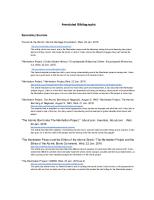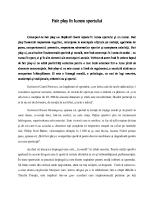History Fair Annotated Bibliography [PDF]
Annotated Bibliography Primary Oppenheimer, J. Robert, Alice Kimball Smith, and Charles Weiner. Robert Oppenheimer, lett
38 0 89KB
Papiere empfehlen
![History Fair Annotated Bibliography [PDF]](https://vdoc.tips/img/200x200/history-fair-annotated-bibliography.jpg)
- Author / Uploaded
- Tommy Riccio
Datei wird geladen, bitte warten...
Zitiervorschau
Annotated Bibliography Primary Oppenheimer, J. Robert, Alice Kimball Smith, and Charles Weiner. Robert Oppenheimer, letters and recollections. Cambridge, Mass.: Harvard University Press, 1980. This compilation of Oppenheimer’s personal thoughts was useful for our group because it gave us a window into Oppenheimer’s thoughts before, during, and after the Manhattan Project. “Hiroshima: Quotes Against the Bombs.” Hiroshima: Quotes. Accessed November 30, 2014. http://www.doug-long.com/quotes.htm. This source compiled powerful quotes from high ranking officials who did not support the bombings. We used quotes from this source from people such as Admiral William D. Leahy and Dwight Eisenhower. "Primary Resources: A Warning from President Truman to Japan Urging Surrender." PBS. Accessed November 20, 2014. http://www.pbs.org/wgbh/americanexperience/features/primary-resources/trumanjapanwarn/. This primary source is a transcript of President Truman’s radio address to the American public on August 9, 1945 explaining the bombings and urging a Janaese surrender. Our group used some quotes from this speech in our “American Reaction” page. "Hiroshima & Nagasaki Remembered." Hiroshima and Nagasaki Remembered. Accessed November 9, 2014. http://www.hiroshima-remembered.com/. This website had an excellent section with first-hand accounts of the bombings from survivors just miles from the hypocenter. Some of those chilling quotes are included in the “Voice From the Rubble” section. "Primary Resources: A Warning from President Truman to Japan Urging Surrender." PBS. Accessed November 20, 2014. http://www.pbs.org/wgbh/americanexperience/features/primary-resources/trumanjapanwarn/. This primary source is a transcript of President Truman’s radio address to the American public on August 9, 1945 explaining the bombings and urging a Janaese surrender. Our group used some quotes from this speech in our “American Reaction” page.
"Hiroshima & Nagasaki Remembered." Hiroshima and Nagasaki Remembered. Accessed November 9, 2014. http://www.hiroshima-remembered.com/. This website had an excellent section with first-hand accounts of the bombings from survivors just miles from the hypocenter. Some of those chilling quotes are included in the “Voice From the Rubble” section. Stimson, Henry. Henry Stinson to Harry Truman, April 24, 1945. Letter. From PBS.org.http://www.pbs.org/wgbh/americanexperience/features/primaryresources/truman-stimson/ (accessed September 17, 2014) This primary source is a letter written by the Secretary of War at the time Henry Stimson to the new President Truman. This letter was important because it was when Truman was informed on the top secret atomic bomb. "Truman Library: The Decision to Drop the Atomic Bomb Online Research File." Truman Library: The Decision to Drop the Atomic Bomb Online Research File. http://www.trumanlibrary.org/whistlestop/study_collections/bomb/large/documents/ index.php?pagenumber=12&documentid=65&documentdate=1946-0619&studycollectionid=abomb&groupid= (accessed September 25, 2014). This primary source had multiple first hand counts from people such as a German Friar, and a Hiroshima native that gave two different perspectives that helped our group more fully understand the extent of the bombings. "Truman Library: The Decision to Drop the Atomic Bomb Online Research File." Truman Library: The Decision to Drop the Atomic Bomb Online Research File. http://www.trumanlibrary.org/whistlestop/study_collections/bomb/large/documents/ index.php?pagenumber=12&documentid=65&documentdate=1946-0619&studycollectionid=abomb&groupid= (accessed September 25, 2014). This primary source had multiple first hand counts from people such as a German Friar, and a Hiroshima native that gave two different perspectives that helped our group more fully understand the extent of the bombings. The Manhattan Project: Making the Atomic Bomb Gosling, Francis G.. The Manhattan Project: Making the Atomic Bomb. Sept. 1994 ed. Washington, D.C.?: History Division, Executive Secretariat, Human Resources and Administration, Dept. of Energy, 1994. Print. This book, written by Francis Gosling, describes the process of creating the atomic bombs, which helped us immensely in understanding the research and design process. The book includes the entire process and testing of the atomic bomb, including the recruiting process and the Einstein letter to President Roosevelt.
Bernstein, Barton J., Truman at Potsdam: His Secret Diary, 1945 (2005), 1-5 Truman’s personal diary from Potsdam, published in 2005 by Barton Bernstein, provided our group with an inside perspective on the Potsdam Conference as well as multiple primary quotes from Truman himself. Groves. Leslie., Memorandum from General L. R. Groves to Secretary of War, The Test, July 18, 1945, Top Secret, Excised Copy, 1945, 1-13 General Leslie Groves was asked to describe in detail the first Trinity Test performed in the desert of New Mexico, which was later used at Potsdam to explain the magnitude and power of the bomb. This source gave our group a detailed, firsthand account of the Trinity Test, using powerful descriptions that convey the sheer force, brightness, loudness, and heat from the detonation of the first atomic bomb. Minutes of Meeting Held at the White House. Truman and Military Advisers. June18, 1945. http://www2.gwu.edu/~nsarchiv/NSAEBB/NSAEBB162/20.pdf This primary source is a meeting that is held at the white house with the President, Fleet admiral, and the General of the Army. This document showed our group Truman’s and The Army’s general thought process on the state of Japan and if it is necessary to put troops on the ground there or use the atomic bombs. Groves, L.R. "Memorandum to the Chief of Staff." National Security Archive. August 6, 1945. Accessed December 10, 2014. http://www2.gwu.edu/~nsarchiv/NSAEBB/NSAEBB162/53.pdf. This primary source is a document by Leslie Groves the day after the bomb of Hiroshima and is a report to the Chief of Staff Marshall. This document gave us primary source information and insight to the scene of Hiroshima the day after the bomb, the effects, and how Groves perceived the effects of the powerful Atomic bomb. Compton, Arthur (1956). Atomic Quest. New York: Oxford University Press. OCLC 173307. This primary source had government documents from the Manhattan Project and gave us a great window into the extensive work that went into the project that took many years to complete. Groves, Leslie (1962). Now it Can be Told: The Story of the Manhattan Project. New York: Harper & Row. ISBN 0-306-70738-1. OCLC 537684. This personal account from Leslie Groves was a great resource for our group to learn about the military side of the Manhattan Project.
Secondary McCullough, David G.. Truman. New York: Simon & Schuster, 1992. David McCullough is a renowned historian and his analysis of President Truman was important for gathering information on him during the early stages of the project, as well as giving us an excellent perspective of Truman that lasted throughout the project. Ferrell, Robert H.. "President Harry S. Truman and the Bomb." National Forum75.4 (1995): 22-26. Print. Robert H. Ferrell’s comprehensive analysis of President Truman and the bomb was important for gathering information about President’s Truman’s role amnd decison making during the Manhattan Project. Stimson, Henry L.. "The Decision to Use the Atomic Bomb." SAIS Review 5.2 (1985): 1-15. Print. This secondary source gave us excellent information about the decision to drop the bombs on both Hiroshima and Nagasaki. Stimson painted an excellent picture of the decision, including arguments for and against the bombs, and President Truman’s feelings about his decision. Taylor, Elaine. "Elaine Tyler May On: American Reaction to Hiroshima and Nagasaki." PBS. Accessed November 5, 2014. http://www.pbs.org/wgbh/amex/bomb/filmmore/ This interview was with historian Elaine Tyler may conducted by PBS was helpful for our group when researching the thoughts of the American public on the bombings. "Avalon Project - The Atomic Bombings of Hiroshima and Nagasaki." Avalon Project The Atomic Bombings of Hiroshima and Nagasaki. Accessed October 24, 2014. http://avalon.law.yale.edu/20th_century/mp10.asp. This sources is a report from Yale Law School with excellent data detailing the mass casualties in Hiroshima and Nagasaki. We used these tables in our website to show the effects of the bombings with concrete data of the devastation. http://www.pbs.org/wgbh/americanexperience/features/general-article/pacific-costs-war/ (accessed September 17, 2014). This source from PBS.org allowed our group to further our knowledge about the nature of the Pacific Theatre during the Second World War, especially the nature of the fighting.
"Peopling the Past: Resources." Peopling the Past: Resources. http://chnm.gmu.edu/acpstah/activities.php?actvID=12 (accessed September 17, 2014). This source is from George Mason University and helped our group gather very important information regarding the American public’s opinion in regards to the Bomb being dropped. Hofstader, Miller, and Aaron. "World War II and the atomic revolution." In The United States Third Edition. 1957. Reprint, Englewood Cliffs, New Jersey: Prentice-Hall, Inc, 1972. 761-762. This source helped gain important analysis about the secrecy of the bomb and increasingly difficult of keeping it secret. It also helped us understand the tremendous power of the bomb. Bernstein, Barton J.. "The Atomic Bombings Reconsidered." Foreign Affairs 74, no. 1 (1995): all. http://web.a.ebscohost.com/hrc/pdfviewer/pdfviewer?sid=4e15aa96-a4104bb0-94b0-e0d157ce7088%40sessionmgr4001&vid=9&hid=4107 (accessed October 1, 2014).s: Groves, Leslie., Oppenheimer's Travel Guidance, July 29, 1943, 1-3. This source came from a collection of previously classified documents that were later declassified by the government years after the Manhattan Project. Written by General Leslie Groves, this document includes the traveling accommodations made for Oppenheimer in order to protect his well-being, which was done for other scientists as well. This source helped us understand the extreme precautions the government took to protect the researchers and the value they placed on the project. Lears, Jackson., Oh God, What Have We Done? London Review of Books, Vol. 34 No. 24 · 20 December 2012, pages 3-8 This source, written by Jackson Lears, is a book review of Inside the Centre: The Life of J. Robert Oppenheimer by Ray Monk which was published in the London Review of Books. Lears review gave our group an idea of the climate in which physicists such as Niels Bohr were able to thrive as young, aspiring scientists as well as the early career of Oppenheimer before the Manhattan Project. "Nuclear Files - From Nuclear Proliferation to Nuclear Testing, from Hiroshima to North Korea, Nuclear Files offers the A to Z on Nuclear issues.." Nuclear Files - From nuclear proliferation to nuclear testing, from Hiroshima to North Korea, Nuclear Files offers the A to Z on nuclear issues.. N.p., n.d. Web. 1 Oct. 2014. . The website “Nuclear Files” offered a wide variety of sources for modern day connections to nuclear power. We utilized this site for our Modern Connections page,
especially when studying the topic of nuclear proliferation and the many controversies involving proliferation. Burr, William. "The Atomic Bomb and the End of World War II: A Collection of Primary Sources." The Atomic Bomb and the End of World War II: A Collection of Primary Sources. N.p., n.d. Web. 23 Sept. 2014.









